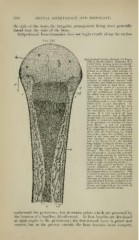Page 576 - My FlipBook
P. 576
586 DENTAL EMBRYoLOdY AND HISTOLOGY
the axis of tlu" bone, tlie invgular arraugciiu'iit beiiit;- must gciuTally
fouiul near the ends of the bone.
Subperiosteal bone-formation does not begin evenly alono- the suriaee
Fig. 326.
Longitudinal Section through the Upper
lliilf of the necalcific'd numerus of a
Fdtal Shet'i), -'^ seen under a niagnify-
iiij; iKiWcriif about :il) dianifters : ;c, tlie
pari (if tlie shall which was jiriuiarily
ussilifd in cartihige; wliat remains of
tile piiiuary bone is represented a.s
dark, enveloped by the clear secondary
deposit. The areohe of the bone are
occupied l)y end)ryonic marrow with
u.sleoblasts, and blood-vessels variously
cut, represented as dark lines. One
long straight vessel (bv) passes in ad-
vance of the line of ossification far
into the cartilaginous head; nuist of
the others loop round close to the car-
tilage. At one or two places in the
older parts t)f the hone elongated grouj)S
of cartilage-cells (ci may still be seen,
which have escaj)ed absorption. im,
the part of the bone that has been
ossilicd in membrane— that is to say, in
the osteoblastic tissue under the peri-
osteum. It is well marked otl' iVoni
tlie central jiortion, and is bounded,
perijiherally, by a jagged edge, the pro-
jections of which are indistinctly seen
to be prolonged by bunches of o.steo-
genic fibres. A row of osteoblasts
covei's the su]H'rticial layer of the bone.
The subjieriosteal layer is prolonged
above into the thickening (/<), which
encroaches u)ion the cartilage of the
head of the bone, and in which are
seen, amongst numerous osteoblasts
and a few blood-vessels, tlie straight
longitudinal osteogenic fibres (< some other fibres { pf) cro.ssing them,
and perhaps representing fibres of
Sharpey. The calcareous salts having
been removed by an acid, the granular
o.ssific deposit i)assing up between the
rows of cartilage-cells is not seen In
this specimen ; it would have extended
as far as a line joining the marks X X.
Observe the general tendency of the
osseous trahecuUe and the vascular
channels between them to radiate from
the original centre of (issilication. This
is found to prevail more or less in all
bones when tliey are fir^t formed,
although the direction of the tiabecula;
may afterward become modified in re-
lation with varying physiological con-
ditions, and espi'cially as the result of
pressure in ditlerent directions.
underneath the periosteum, but at certain points which are governed by
tlie location of a cai)illary blood -ves.sel. At fir.st lamelLie are develo])ed
at riij;ht anuies to the jieriosteum ; the first-formed layer is pitted and
uneven, but as the jjroccss extends the bone becomes more compact,


